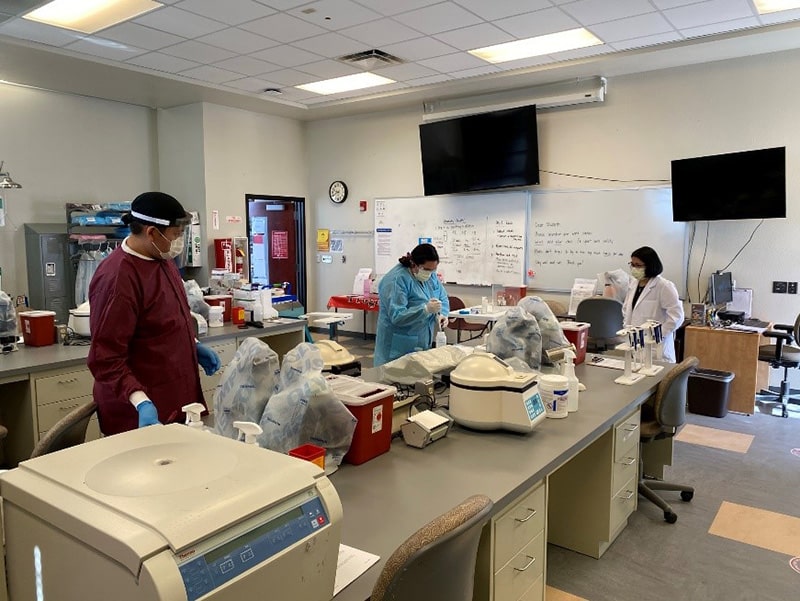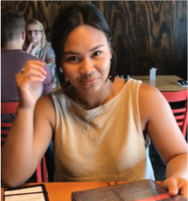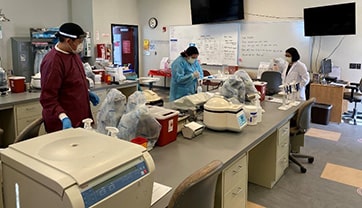UNM-GALLUP COMMUNITY PERSISTS DURING HYBRID FALL SEMESTER.
Categories: Students Faculty Staff Community
By Lee Lamb - Monday, October 12, 2020
When the COVID-19 pandemic emerged over seven months ago in March, it immediately impacted the educational experiences of UNM-Gallup students and faculty—and caused the normal course and experiences of a college semester to abruptly shift to virtual and other online formats.
The most immediate concern for faculty at the onset of this pandemic was to figure out how to complete courses in progress in some fashion. For faculty, that meant communicating with students through e-mail or by phone and relying more heavily on UNM Learn—an online course delivery system— to create assignments that could be delivered and graded virtually instead of in-person. In-class group activities were turned into individualized projects. And, some instructors received what amounted to a crash course in UNM Learn to establish a basic educational space where they could provide materials or videos to substitute for what would have been delivered in the classroom.
“Another big issue for all of us was trying to help students who really didn’t have the means to convert to online instruction,” explains Dr. Tracy Lassiter, who is an assistant professor at UNM-Gallup. “We had to think through solutions when home-based Wi-Fi or computer access was limited or non-existent and when resources such as the library were inaccessible or closed.”
For a few students with limited or no Internet access, the solution when this pandemic emerged was somewhat clumsy but functional. Faculty would email the student an assignment, and the student would then read that email on their phones—and either reply to complete the work in email or copy down the questions and answer them on paper, take a photo of their work, and then upload or email the assignment back to their instructor.
“Our challenge early on was trying to help students successfully complete courses while scrambling to come up with material which was to be provided via a flipped mode of delivery with varying degrees of technological skill,” says Dr. Lassiter.
Since the onset of the pandemic—and to assist students with access issues—UNM-Gallup has worked to provide affordable laptop solutions through the bookstore, Wi-Fi hotspots through the library, and boosted Wi-Fi access in campus parking lots. The Zollinger Library also adapted its services to include appointments for students to access books and the over 18 study carrels with computer and Internet services.
Faculty and students certainly had to—and continue to do so—think quite differently about how to continue essential elements of their coursework. Instead of being able to hold student presentations in person, for example, faculty now have class members present to and evaluate one another virtually using uploads into learn groups or utilizing technology such as Zoom or YouTube. Instructors also created their own YouTube channels so that students could record a video at home to demonstrate a technical skill and then upload their video to the course channel.
This past summer, faculty sharpened their online delivery skills as well with investments made campus-wide in online course training that assisted with course design and other refinements to instruction in preparation for this fall semester.
“The administration recognized the need to train faculty in online course design and delivery and help build courses throughout the summer,” explains Dr. Lassiter. “Faculty members could, in turn, assist other colleagues in their course delivery. Every faculty member who wanted to learn more about designing courses in UNM Learn was able to do so.”

Caption: A few essential skill courses and labs are held during the hybrid fall semester at UNM-Gallup with students learning in adapted learning environments that allow for social distancing and other safety protocols. Sean Klass (left) and Danielle Chischilly (right) are shown analyzing labs with instructor Corine Gonzales observing their technique.
FACULTY, STAFF, AND STUDENTS SHARE CAMPUS EXPERIENCES
UNM-Gallup nursing student Ellen Apura—who is more than halfway through her bachelor's degree in Nursing—has experienced these innovations and shifts in learning formats firsthand throughout this pandemic. “Having to merge to remote learning so suddenly at the beginning of this pandemic felt so strange to me,” she explains. “It has been a wild ride of learning especially for the last couple of months, but surely we are getting to the finish line.”

Caption: Ellen Apura, BSN student at UNM-Gallup
As a nursing student, Apura explains, it has been a bit of a challenge to learn solely online.
“Throughout nursing school, a student learns different concepts in theory and through practice in lab spaces. Our program did break up our classes for some on-campus instruction and lab sessions with smaller groups. I find this approach to be really helpful since there are going to be important nursing skills that we can’t just learn by reading, such as IV insertions and properly taking vital signs.” She also says that campus safety protocols—social distancing, wearing appropriate face masks and other protective equipment—are reassuring while students are in the lab brushing up on their skills.
With this hybrid approach to her classes, Apura has found some perks throughout these past months. “At first, it was odd to not follow my usual morning routine of waking up at the break of dawn to get ready for a dreadful 40-minute commute to campus. But I found myself squeezing in a few extra minutes of sleep from what would have been my travel time to school.” With being able to learn mostly from home, Apura adds that she is grateful that her family has been able to stay safe throughout this pandemic.
Chris Chavez, who is a lecturer in construction technology, suggests that his students are adapting similarly in his courses that are also being delivered in a hybrid format. “We offer online and in-person courses that are adapted to the masking and distancing requirements in our lab spaces that can accommodate eight to 10 students with these protocols,” he says. “Sanitation protocols have also required our program to purchase additional equipment and tools to avoid students sharing materials during safety testing and project work.”
Chavez also explains that he’s enjoying some of the online aspects of his classes, since it allows him to connect with students at times other than the designated class—which provides him with the opportunity to offer extra materials and directions through UNM Learn. “Students have adapted to the safety requirements, and I’ve not had any complaints since the protocols are similar to what we do in the industry. Our instruction on campus, though limited, is basically the same as previous semesters.”
Student services is another essential area of campus operation that has directly witnessed the many changes students and faculty have endured throughout this pandemic. Kimimila Simms, who is the program director for TRIO and Student Support Services, outlines many of the challenges her team has overcome directly as a result of the pandemic.
“For us, the biggest challenge has been not being able to visually connect and check-in with the students in person; and not being that consistent college-life contact in their school lives,” Simms says. “Not knowing what a student is experiencing at school and at home has been a challenge that we’ve worked to overcome.”
To compensate for the lack of in-person interaction that would occur during the course of a normal semester at UNM-Gallup, Simms explains that Student Affairs and the TRIO program have established various avenues and opportunities to meet with students, including a weekly coffee and tea hour scheduled over Zoom.
“Our peer mentors reach out to have one-on-one sessions with students; our staff reach out for advisement sessions; and we are now gearing up for FAFSA and financial literacy workshops. We have incorporated text messaging, UNM Learn, and social media to engage with students and let them know that we are making every effort to help them succeed throughout this semester.”
Simms adds that it’s a collective effort to continuously adapt and implement best practices to help students finish the semester strong. “We’ve definitely all become more tech savvy,” she exclaims. “The students have adapted and are learning right along with us.”
It’s notable to also add that this department has extended their hours often into the late evening to accommodate student schedules that are now more difficult to navigate with home and school responsibilities.
“I’d like to remind students to keep reaching out and communicating with us and their instructors—we all want to provide academic support in the best ways possible. And to finish this fall semester strong. We all believe in you,” she says encouragingly.
With all the challenges this pandemic has brought to the UNM-Gallup community, it has also brought out the best in the faculty, staff, and students who have worked so incredibly hard together over these past seven months to persist and persevere in overcoming the many challenges these difficult times have brought to campus and their daily lives. From overcoming connectivity and access issues, to the changing schedules and ongoing shifts in course formats, it has truly been a campus-wide endeavor to ensure each student has the resources they need to achieve their education goals.
While this pandemic persists, so does the ingenuity of UNM-Gallup faculty, students, and personnel. It is said throughout the UNM system that “each of us defines all of us,” and that cannot be any truer today through the strength exhibited by each member of UNM-Gallup throughout this pandemic.
UNM-Gallup Article Contact:
Lee Lamb, Senior Public Relations Specialist | lambc@unm.edu
Latest News
Zollinger Library December Events
UNM-Gallup to host Holiday in New Mexico event Dec. 4
UNM-Gallup showcases Indigenous culture at library directors retreat
Paving the way for new partnerships
The University of New Mexico - Gallup
705 Gurley Ave.
Gallup, NM 87301
(505) 863-7500
Explore more News options:
UNM-G News UNM-G Events Speakers Bureau Press Release Archives



